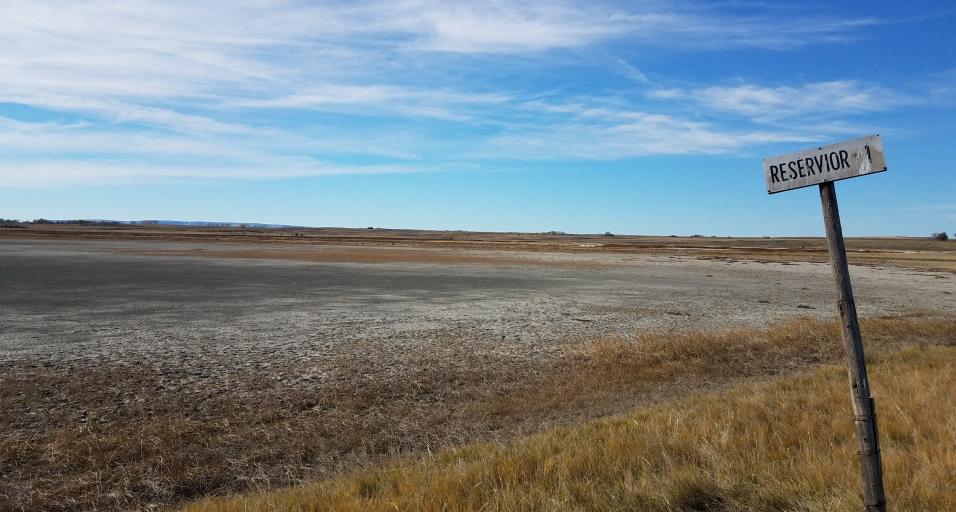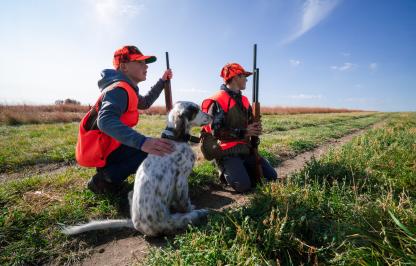Waterfowl hunters may have noticed the lack of water in ponds at Table Mountain Wildlife Habitat Management Area (WHMA). Wyoming Game and Fish Department biologists say there isn’t any water available to fill the ponds and as a result conditions will be challenging for waterfowl hunters.
Table Mountain WHMA is 15 miles southeast of Torrington. In 1962, the Wyoming Game and Fish Commission entered into a cooperative agreement with the U.S. Bureau of Land Management (BLM) to manage 1,716 acres of Canada goose habitat. Game and Fish has made extensive wetland improvements, resulting in one of the most important wetland areas in southeast Wyoming. This area is an important staging area for thousands of ducks and geese each spring and during the fall migration.
During the winter the Habitat and Access crew installs and monitors ice eaters on Pond 1 to create open water for waterfowl. Game and Fish, in partnership with the BLM and the Goshen County 2-Shot Goose Hunt, have worked to increase the vegetation in the abundant marshlands and by installing goose-nesting structures. But without water in the ponds, waterfowl hunters have a challenging hunting season ahead.
While the diversion pond is full, the remaining eight ponds at Table Mountain WHMA currently contain little to no water. “This is the third year of drought in the area; water simply is not available for these ponds at this time,” said Jerry Cowles, Habitat and Access supervisor for the Laramie Region. The Department’s beneficial use water for propagation allows the agency to fill Table Mountain ponds from October through April or until irrigation starts up again. With that said the Department is collecting every drop to fill the ponds.
Water for the Table Mountain ponds comes off Dry Creek which is a tributary of Horse Creek that flows onto the southwestern edge of the property. In a year with normal precipitation, 32-33 acre feet flow through the Horse Creek drainage consistently from Oct. 1 to the end of December. “The State Engineer’s Office monitors water flow through a measuring device on Horse Creek near the Goshen and Laramie county line, and there is currently only 22 acre feet coming in,” Cowles said.
Under current water rights, water from Horse Creek first fills Hawk Springer Reservoir. When Hawk Springs is partially full (approximately 13,000 acre feet), water then goes to Springer Reservoir, Packers Lake, and other area ponds before Table Mountain WHMA receives any. With irrigation a priority for water rights during the growing season, Table Mountain generally receives most of its water from February through the end of April.
“Normally, there would be 5 acre feet of water going into the Table Mountain ponds this time of year, but they’re currently only receiving .32 cubic feet/second, which is about a tenth of an acre foot,” Cowles said. “With .32 cubic feet/second this is barely enough to offset the evaporation loss for one day.”
To supplement water in the ponds, the Department has water well running into Pond 2. “But it only provides 100 gallons per minute, so it’s not very much,” Cowles said. While the area received more than an inch of precipitation with recent storms, it wasn’t enough to make a difference for the Table Mountain ponds.
As a result, waterfowl hunters will have limited opportunities at Table Mountain WHMA this season. Rawhide WHMA is still open to hunting for waterfowl, and there are a few walk-in areas that provide field hunting as an option. Waterfowl hunters can also hunt at Bump Sullivan Reservoir, which is currently about half full. “But there aren’t many other options for public hunting in this area,” said Wheatland Wildlife Biologist Keaton Weber.
Hunters are reminded that Pond #1 at Table Mountain WHMA and part of Springer Reservoir are closed to hunting, and Hawk Springs Reservoir closes Nov. 12 for waterfowl. “The bottom line is, we don’t have any water. It’s up to Mother Nature,” Cowles said.



